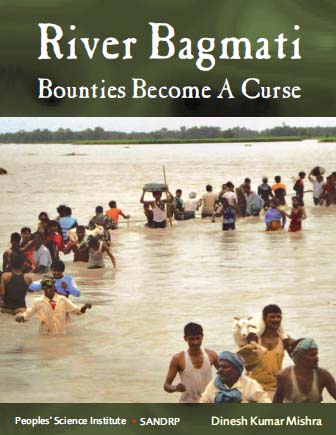Dinesh Kumar Mishra
Flawed embankment strategy converts Bihar into a watery grave
Posted on 27 Jul, 2015 02:31 PMDr. Dinesh Kumar Mishra of Barh Mukti Abhiyaan, an authority on the river network of North Bihar speaks to India Water Portal about the flood problems, the skewed flood control policy of the Government, the Kosi breach of 2008 and the gargantuan interlinking of rivers project.

Embankments: Engineering solutions or problems?
Posted on 02 Mar, 2015 05:12 PMMahananda, a major River of north Bihar rises in the Darjeeling district of West Bengal. It meets the Ganga after a journey of 376 km through the flat lands of Bihar, West Bengal and Bangladesh. It would spill its banks because of the flat slopes, causing deluge and waterlogging in the Katihar district of Bihar.

Bihar's great walls of destruction
Posted on 07 May, 2014 10:49 PMBorn out of the sea, the Ganga basin is a playground of the rivers coming down from the Himalayas. Floods are not a new thing in Bihar, a state in the lap of these flood plains. For centuries, the people here have lived with these waters, with the floods washing away their lands once a year, slowly, leaving behind a blanket of rich and fertile silt.

Engineering witchcraft in Bihar
Posted on 09 Feb, 2014 07:46 PMIt's been years since Bhutahi Balan, a small tributary of the Kosi river in Madhubani, North Bihar, has been causing devastation on both its banks. Dinesh Mishra in his book 'Story of a ghost river and engineering witchcraft' objectively analyses the failure of embankments, which are raised banks to contain the river's flooding.

River Bagmati: Bounties become a curse – A book by Dinesh Kumar Mishra
Posted on 14 Oct, 2012 05:20 PM
Resuscitating a failed idea - Notes from Bihar – A paper in Economic and Political Weekly
Posted on 07 May, 2012 11:36 AMThis article by Dinesh Kumar Mishra, Convenor of the Barh Mukti Abhiyan (movement for freedom from floods), Bihar in the Economic and Political Weekly states that the idea of a national interlinking of rivers needs to base itself on the past six decades’ experience of river and flood control measures.
Scientific and technological approaches for sustainable use of water resources: Summary of the Global Indian Scientists and Technocrats Forum convention held at Pune, in December 2010
Posted on 09 Apr, 2012 11:17 PMThe sessions were as follows:
Villages in north Bihar sinking in Bagmati's sand - Entire flood control planning needs thorough review - Article by Dinesh Kumar Mishra in d-sector.org
Posted on 16 Jun, 2011 03:56 PM The Bagmati Embankment separating riverside on the left and countryside of the right near Ibrahimpur – Electric poles suggest the height of the embankment
The Bagmati Embankment separating riverside on the left and countryside of the right near Ibrahimpur – Electric poles suggest the height of the embankment
One often hears about the civilizations buried under earth and attributes various reasons for such disappearance of life from a particular place. Excavations reveal the way of life the people might have had before they chose to leave their villages and towns and allowed the nature to take its own course. These accounts are available in books and we all believe the process told to us by historians and archaeologists. These are all conjectures that are revealed by scientific investigations but how many of us have seen, not read, how the civilizations get buried under the debris created by nature? There are places in Bihar where one can see the process of disappearance of civilization and the villages getting buried under the sediments brought by rivers.
Embankments related compensation to drain Indian exchequer : Need to review the flood control policy of the Government
Posted on 16 Dec, 2010 03:14 PMGovernment of Nepal has asked the Government of India to compensate its citizens badly affected by embankments and other flood control measures taken on river Gandak. Will this not lead to a flood of demands for compensation by the victims of similar problems in other river basins like the Bagmati, the Kamala and the Kosi?
Kosi darshan: A deeper look at the lives of those pinned on the river
Posted on 31 Mar, 2009 05:14 PM"If it had not breached at Kusaha, it would have anyway breached at this point," points a villager towards the probable location on the eastern bank in village Rajabaas near Prakashpur in Sunsari district of Nepal, located 14 km upstream of Kusaha where the Eastern Afflux embankment of the Kosi had breached on the August 18, 2008.